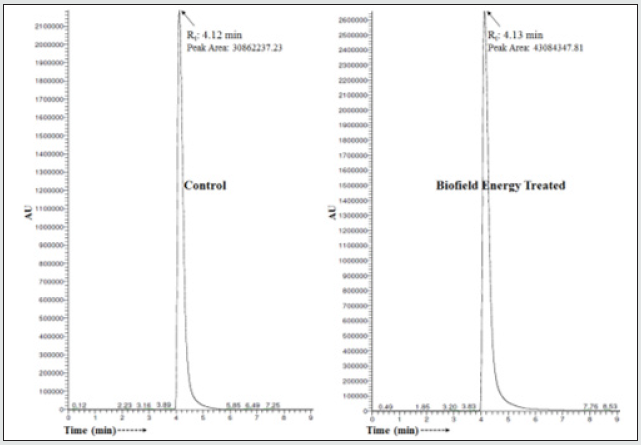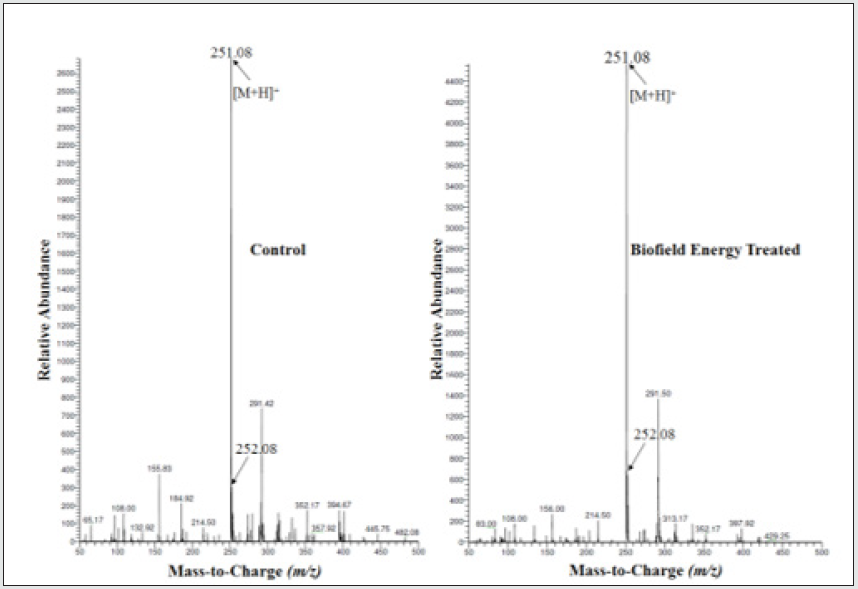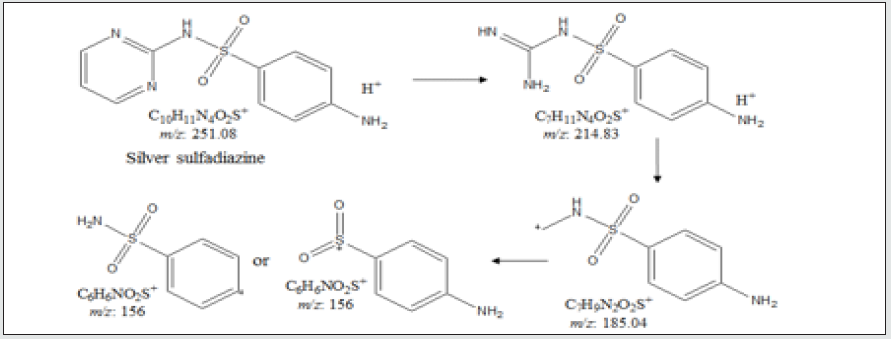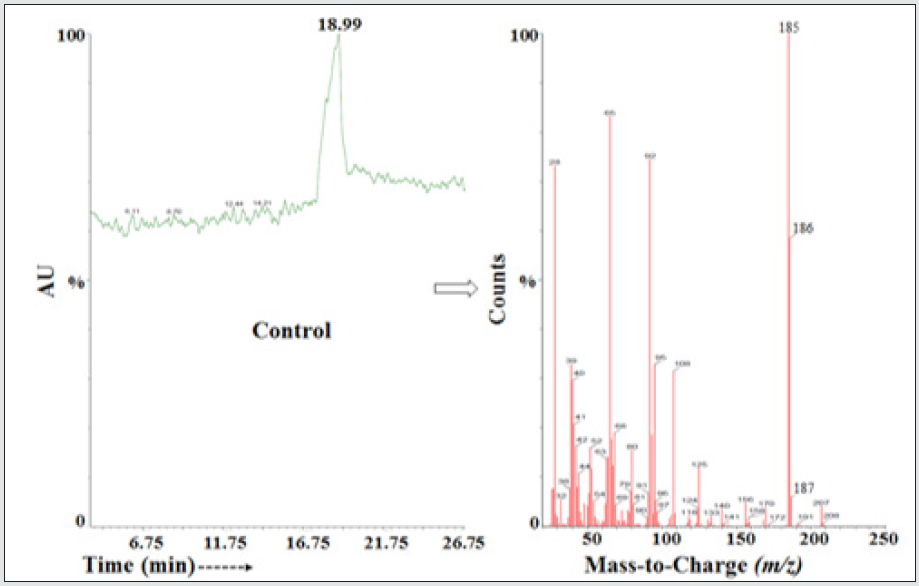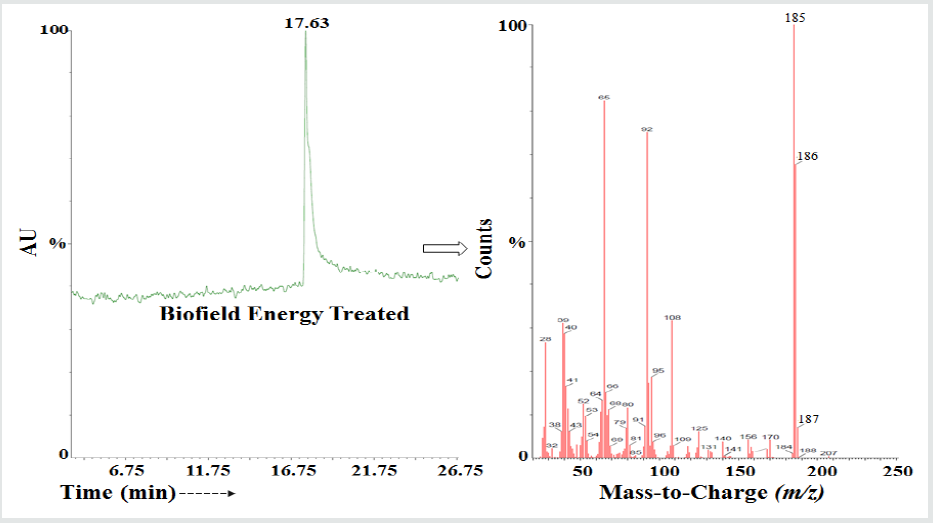
Lupine Publishers Group
Lupine Publishers
Menu
ISSN: 2637-6679
Research Article(ISSN: 2637-6679) 
Influence of The Consciousness Energy Healing Treatment on The Isotopic Abundance Ratio of Silver Sulfadiazine Volume 6 - Issue 2
Mahendra Kumar Trivedi1, Alice Branton1, Dahryn Trivedi1, Snehasis Jana*2
- 1Trivedi Global, Inc., Henderson, USA
- 2Trivedi Science Research Laboratory Pvt. Ltd., Thane (W), India
Received: March 08, 2021 Published: March 17, 2021
Corresponding author: Snehasis Jana, Trivedi Science Research Laboratory Pvt. Ltd., Thane (W), Maharashtra, India.
DOI: 10.32474/RRHOAJ.2021.06.000232
Abstract
Silver sulfadiazine is a topical antimicrobial antibiotic. It is useful in the presentation and treatment of wound infections with severe burns. In this study, the impact of the Trivedi Effect® on the isotopic abundance ratios (PM+1/PM and PM+2/PM) of silver sulfadiazine was analyzed using LC-MS and GC-MS analytical techniques compared to the control sample. The silver sulfadiazine sample was divided into control and treated parts. Only the treated part of silver sulfadiazine was received the Trivedi Effect®- Consciousness Energy Healing Treatment remotely by a well-known Biofield Energy Healer, Mahendra Kumar Trivedi. The LC-MS spectra of both the samples at retention time ~4 minutes exhibited the mass of the protonated molecular ion peak at m/z 251 (calculated for C10H11N4O2S+, 251.06) was found to be sulfadiazine. The chromatographic peak area of the treated sulfadiazine was significantly increased by 17.31% compared to the control sample. This indicated that the solubility of the treated silver sulfadiazine must have increased significantly after the Biofield Energy Treatment compared with the control sample. The LC-MS based isotopic abundance ratio of PM+1/PM in the treated sulfadiazine was significantly increased by 25.18% compared with the control sample. Similarly, the GC-MS based isotopic abundance ratio of PM+1/PM and PM+2/PM in the treated sulfadiazine was significantly increased by 15.74% and 18.64%, respectively compared with the control sample. Hence, 13C, 2H, 15N, 17O, 33S, and 34S contributions from (C7H9N2O2S)+ to m/z 186 and 187 in the treated sulfadiazine were significantly increased compared to the control sample. Thus, the isotopic abundance ratios of PM+1/PM (2H/1H or 13C/12C or 15N/14N or 17O/16O or 33S/32S) and PM+2/PM (34S/32S) in the treated sulfadiazine were significantly increased compared to the control sample. The changes in isotopic abundance and peak area might be due to changes in nuclei possibly via the interference of neutrino particles controlled by the Trivedi Effect®-Consciousness Energy Healing Treatment. The increased isotopic abundance ratio of the treated silver sulfadiazine might improve the chemical bond strength and stability. This novel silver sulfadiazine would be more efficacious in pharmaceutical formulations which might offer better solubility, bioavailability, and therapeutic response against bacterial infections, superficial and partial thickness burn injuries, etc.
Keywords: The Trivedi Effect®; Consciousness Energy Healing Treatment; Silver Sulfadiazine; LC-MS; GC-MS.
Introduction
Silver sulfadiazine is a topical antimicrobial antibiotic. It is useful in the presentation and treatment of wound infections with severe burns. The antibacterial and antifungal activities are the combined effects of both silver and sulfadiazine [1]. The mechanism of action of silver sulfadiazine, in which silver sulfadiazine interacts with the sodium chloride of the body fluids, releases the silver ions. The silver ion slowly released into wounded areas and form the disulphide bonds leading to the structural changes in protein and inactivating thiol-containing enzymes [2]. It inhibits the bacteria by intercalating its DNA and interfere in the process of replication and transcription [3, 4]. The common side effects associated with it are itching, burning secession and pain on the skin, trouble breathing, etc. [5]. The bioavailability of silver sulfadiazine is a major concern, which is very poor [<1% (silver), 10% (sulfadiazine)] [6]. The physicochemical properties of a drug have lots of role in the solubility, absorption, bioavailability, etc. [7]. Therefore, many researches are going on to improve the quality of the drug substance. The Trivedi Effect®- Consciousness Energy Healing Treatment (Biofield Energy Healing Treatment) has an unbelievable impact on the physicochemical properties of pharmaceutical compounds [8-11]. The Trivedi Effect® is a natural and only scientifically proven phenomenon in which an expert individual can harness this inherently intelligent energy and transfer it anywhere on the planet via the possible mediation of neutrinos [12]. A “Biofield” is an electromagnetic energy field that exists surrounding the living body, which is generated by the continuous movement of the electrically charged particles like ions, cells, etc. inside the body. Biofield Energy Healer can harness the energy from the “Universe” and can transfer into any living and non-living object(s), the process of treatment is called Biofield Energy Healing Treatment [13, 14].
Energy Therapies have also been reported with significant outcomes against various diseases [15]. The National Center of Complementary and Integrative Health (NCCIH) has recognized and accepted Biofield Energy Healing as a Complementary and Alternative Medicine (CAM) health care approach along with the other therapies, medicines, and practices such as Ayurveda, Chinese herb and medicine, Reiki, Tai Chi, yoga, hypnotherapy, Qi Gong, etc. [16]. These therapies have been accepted by most of the USA people [17]. The Trivedi Effect®-Consciousness Energy Healing Treatment also altered the characteristic properties of the metals, and ceramic, crops, microbes, nutraceutical compounds [18-26] and the isotopic abundance ratio of many organic compounds [27, 28]. The investigation of the stable isotope ratio has various applications in different fields of science to understand the isotope effects resulting from the variation of the isotopic composition of the molecule [29, 30]. The isotope ratio analysis can be performed by using mass spectrometry techniques. Now a days sophisticated analytical technique such as gas chromatographymass spectrometry (GC-MS) and liquid chromatography-mass spectrometry (LC-MS) were used in low micromolar concentration with appropriate precision [30, 31]. In this study, the impact of the Trivedi Effect®-Consciousness Energy Healing Treatment on the isotopic abundance ratios (PM+1/PM and PM+2/PM) of silver sulfadiazine were analyzed using LC-MS and GC-MS analytical techniques compared to the control sample.
Materials and Methods
Chemicals and Reagents
The test sample silver sulfadiazine was purchased from Tokyo Chemical Industry Co., Ltd., Japan and remaining chemicals like acetonitrile and ammonium acetate were purchased from Merk, India.
Consciousness Energy Healing Treatment Strategies
The silver sulfadiazine powder sample was divided into two parts. One part of the sample received no Biofield Energy Treatment is called the control silver sulfadiazine. But, the control sample received treatment from a “sham” healer who did not have any knowledge about the Biofield Energy Treatment. However, the other part of the sample received the Trivedi Effect®-Consciousness Energy Healing Treatment remotely for 3 minutes under standard laboratory conditions by the renowned Biofield Energy Healer, Mahendra Kumar Trivedi, USA. The Consciousness Energy Healing Treated sample was termed as the Biofield Energy Treated silver sulfadiazine. After that, both the test samples were kept in sealed conditions and characterized using LC-MS and GC-MS analytical techniques.
Characterization
Liquid Chromatography-Mass Spectrometry (LC-MS) Analysis and Calculation of Isotopic Abundance Ratio
The LC-MS analysis of both the samples was carried out with the help of LC-MS Thermo Fisher Scientific, the USA, fitted with an ion trap detector connected with a triple-stage quadrupole mass spectrometer. The reversed phase column used here was Thermo Scientific Synchronis C18 (Length-250 mm X ID 4.6 mm X 5 micron), maintained at 25˚C. The diluent for the sample preparation was methanol and the injection volume was 5 μL. The analyte was eluted using a gradient mobile phase of acetonitrile + 10 mM ammonium acetate (80:20) pumped at a constant flow rate of 0.6 mL/min with a total run time of 10 min. Peaks were monitored at 254 nm using the PDA detector. The mass spectrometric analysis was performed under +ve ESI mode. The total ion chromatogram and mass spectrum of the individual peak were recorded. The natural abundance of each isotope (C, H, N, O, and S) can be predicted from the comparison of the height of the isotope peak with respect to the base peak. The values of the natural isotopic abundance of the common elements are obtained from the literature [30, 32-34]. The LC-MS based isotopic abundance ratios (PM+1/PM) for the control and Biofield Energy Treated silver sulfadiazine was calculated using equation 1.
% Change in isotopic abundance ratio = [(IARTreated – IARControl)/ IARControl) x 100] (1)
Where IARTreated = isotopic abundance ratio in the treated sample and IARControl = isotopic abundance ratio in the control sample.
Gas chromatography-mass spectrometry (GC-MS) analysis
The samples of silver sulfadiazine also analyzed with the help of Perkin Elmer Gas chromatograph equipped with a PE-5MS capillary column (30M x 250 micros x 0.250 microns) and attached to a single quadrupole mass detector was operated with electron impact (EI) ionization in +ve ion mode. The oven temperature was maintained from 75°C (5 min hold) to 280°C (14.5 min hold) @ 10°C/min with a total run time of 40 min. The sample was prepared taking 60 mg of the silver sulfadiazine in 4 ml dimethyl sulfoxide. The identification and characterization of silver sulfadiazine were confirmed by GC retention times and by a comparison of the mass spectra of samples. The GC-MS based isotopic abundance ratios (PM+1/PM and PM+2/PM) for both the samples were calculated using equation 1.
Results and Discussion
Liquid Chromatography-Mass Spectrometry (LC-MS)
The silver sulfadiazine showed the single major chromatographic peak at the retention time (Rt) of ~4 minutes in the chromatograms in case of both the samples (Figure 1). The peak area of the treated sample was significantly increased by 39.6% compared to the control sample. The result was supported by the previous study, where the particle size of the Biofield Energy Treated silver sulfadiazine was significantly decreased and surface area was significantly increased by 17.31% compared to the control sample [9]. Thus, the solubility profile of the Biofield Energy Treated silver sulfadiazine would have increased significantly after the Biofield Energy Treatment compared with the control sample. The silver sulfadiazine samples showed the protonated molecular mass peak [M+H]+ at m/z 251 (calculated for C10H11N4O2S+, 251.06) with 100% base peak intensity in the MS spectrum was found to be sulfadiazine (Figure 2). The experimental data were well matched with the reported literature data [35]. Along with the molecular ion peak other fragmentation peaks at m/z 214.5, 185, and 156 for C7H11N4O2S+, C7H9N2O2S+, and C6H6NO2S+, respectively in both the samples (Figures 2 and 3).
The theoretical calculation of PM+1 for sulfadiazine was presented as below:
P (13C) = [(10 x 1.1%) x 100% (the actual size of the M+ peak)] / 100% = 11%
P (2H) = [(11 x 0.015%) x 100%] / 100%= 0.165%
P (15N) = [(4 x 0.4%) x 100%] / 100% = 1.6%
P (17O) = [(2 x 0.04%) x 100%] / 100% = 0.08%
P (33S) = [(1 x 0.75%) x 100%] / 100% = 0.75%
PM+1, i.e. 13C, 2H, 15N, 17O and 33S contributions from (C10H11N4O2S)+ to m/z 252.08 = 13.6%
From the above calculation, it has been found that 13C, 15N, and 33S have major contribution to m/z 252.08. The calculated isotopic abundance (13.6%) is close to the experimental value 11.24% (Table 1). The isotopic abundance ratio analysis PM and PM+1 for sulfadiazine near m/z 251.08 [M+] and 252.08 [(M+1)+], respectively of both the samples in the ESI-MS spectra (Table 1). The percentage change of the isotopic abundance ratio (PM+1/PM) in the treated sulfadiazine was significantly increased by 25.18% compared with the control sample (Table 1). Therefore, it was concluded that the 13C, 2H, 15N, 17O, and 33S contributions from (C10H11N4O2S)+ to m/z 252.08 in the treated sulfadiazine were significantly increased compared to the control sample.
Table 1. The isotopic abundance analysis of the treated sulfadiazine compared to the control sample.

PM: the relative peak intensity of the parent molecular ion [M+].
PM+1: the relative peak intensity of the isotopic molecular ion [(M+1)+].
M: mass of the parent molecule.
Gas Chromatography-Mass Spectrometry (GC-MS) Analysis
The control and treated silver sulfadiazine showed a sharp chromatographic peak at the Rt 18.99 and 17.63 minutes, respectively in the GC-MS chromatograms (Figures 4 and 5). The change in the Rt indicated a change in the polarity of the treated sulfadiazine compared to the control sample. This indicated that the solubility of the treated silver sulfadiazine was altered compared to the control sample, which was supported by the LC-MS data and previously published article [9]. The GC-MS of silver sulfadiazine did not show the parent molecular ion peak in the mass spectra but, the base peak of methyl sulphonamide was observed at m/z 185 (calculated for C7H9N2O2S+, 185.04), along with the lower mass fragment ion peaks (Figures 4 and 5).
The theoretical calculation of PM+1 and PM+2 for silver
sulfadiazine was presented as below:
P (13C) = [(7 x 1.1%) x 100% (the actual size of the M+ peak)]
/ 100% = 7.7%
P (2H) = [(9 x 0.015%) x 100%] / 100%= 0.135%
P (15N) = [(2 x 0.4%) x 100%] / 100% = 0.8%
P (17O) = [(2 x 0.04%) x 100%] / 100% = 0.08%
P (33S) = [(1 x 0.75%) x 100%] / 100% = 0.75%
PM+1, i.e. 13C, 2H, 15N, 17O, and 33S contributions from
(C7H9N2O2S)+ to m/z 185 = 9.47%
Similarly,
P (34S) = [(1 x 4.21%) x 100%] / 100% = 4.21%
PM+2, i.e. 34S contributions from (C7H9N2O2S)+ to m/z 186
= 4.21%
From the above calculation, it has been found that 13C, 15N,
33S, and 34S have the major contributions to m/z 185 and 186.
The GC-MS based isotopic abundance ratio analysis of the Biofield
Energy Treated samples were calculated compared to the control
sample. PM, PM+1, and PM+2 for silver sulfadiazine near m/z 185
[M+], 186 [(M+1)+], and 187 [(M+2)+], respectively of the control
and Biofield Energy Treated samples in the mass spectra (Table 2).
The isotopic abundance ratio of PM+1/PM and of PM+2/PM in the
treated silver sulfadiazine was significantly increased by 15.74%
and 18.64%, respectively compared to the control sample (Table
2). Hence, 13C, 2H, 15N, 17O, 33S, and 34S contributions from
(C7H9N2O2S)+ to m/z 186 and 187 in the Biofield Energy Treated
sample were significantly increased compared with the control
sample.
Table 1. The isotopic abundance analysis of Biofield Energy Treated sulfadiazine compared to the control samples.

PM: the relative peak intensity of the parent molecular ion [M+].
PM+1: the relative peak intensity of the isotopic molecular ion [(M+1)+].
PM+2: the relative peak intensity of the isotopic molecular ion [(M+2)+].
M: mass of the parent molecule.
The LC-MS and GC-MS based isotopic abundance ratios of PM+1/PM (2H/1H or 13C/12C or 15N/14N or 17O/16O or 33S/32S) and PM+2/PM (34S/32S) in the treated sulfadiazine were significantly improved compared to the control sample. The alteration in isotopic abundance ratios might be due to changes in nuclei possibly through the interference of neutrino particles via the Trivedi Effect®-Consciousness Energy Healing Treatment. Neutrino is an elementary particle with ½ integer spin, which interacts only via the weak subatomic force and gravity. The neutrinos have the ability to interact with the nucleus, which indicated a close relation between neutrino and the isotope formation [12, 30, 31]. The improved isotopic abundance ratios (PM+1, and PM+2) would highly influence the atomic bond vibration of the treated silver sulfadiazine [35]. The increased isotopic abundance ratio of the Consciousness Energy Healing Treated silver sulfadiazine would stronger the chemical bond and increase the stability in the body. The Trivedi Effect®-Consciousness Energy Healing Treated silver sulfadiazine might improve the solubility, bioavailability, pharmacokinetic profile, and therapeutic efficacy, which would be more advantageous in the prevention and treatment of bacterial infections, superficial and partial thickness burn injuries, etc.
Discussion
The Biofield Energy Treated silver sulfadiazine showed a significant impact on the peak area and isotopic abundance ratios after the Trivedi Effect®-Consciousness Energy Healing Treatment compared to the control sample. The LC-MS spectra of both the samples at retention time ~4 minutes exhibited the mass of the protonated molecular ion peak at m/z 251 (calculated for C10H11N4O2S+, 251.06) was found to be sulfadiazine. The chromatographic peak area of the Biofield Energy Treated sulfadiazine was significantly increased by 17.31% compared to the control sample. This indicated that the solubility of the treated silver sulfadiazine must have increased significantly after the Biofield Energy Treatment compared with the control sample. The LC-MS based isotopic abundance ratio of PM+1/PM in the Biofield Energy Treated sulfadiazine was significantly increased by 25.18% compared with the control sample. Similarly, the GC-MS based isotopic abundance ratio of PM+1/PM and PM+2/PM in the treated sulfadiazine was significantly increased by 15.74% and 18.64%, respectively compared with the control sample. Hence, 13C, 2H, 15N, 17O, 33S, and 34S contributions from (C7H9N2O2S)+ to m/z 186 and 187 in the Biofield Energy Treated sulfadiazine were significantly increased compared to the control sample. Thus, the isotopic abundance ratios of PM+1/PM (2H/1H or 13C/12C or 15N/14N or 17O/16O or 33S/32S) and PM+2/PM (34S/32S) in the Biofield Energy Treated sulfadiazine were significantly increased compared to the control sample. The changes in isotopic abundance and peak area might be due to changes in nuclei possibly via the interference of neutrino particles controlled by the Trivedi Effect®- Consciousness Energy Healing Treatment. The increased isotopic abundance ratio of the Consciousness Energy Healing Treated silver sulfadiazine might improve the chemical bond strength, led to increase the stability in the body. This novel silver sulfadiazine would be more efficacious in pharmaceutical formulations which might offer better solubility, bioavailability, and therapeutic response against bacterial infections, superficial and partial thickness burn injuries, etc.
Acknowledgements
The authors are grateful to Sophisticated Instrumentation Centre for Applied Research & Testing (SICART) India, Trivedi Science, Trivedi Global, Inc., Trivedi Testimonials, and Trivedi Master Wellness for their assistance and support during this work.
References
- Marx J, Walls R, Hockberger R (2013) Rosen's Emergency Medicine-Concepts and Clinical Practice. Elsevier Health Sciences 2: 8th Edn.
- World Health Organization (2009) "WHO Model List of Essential Medicines". 205: pp.126.
- Herbert SR, Howard SC (1972) Silver Sulfadiazine: Effect on the Growth and Metabolism of Bacteria. Antimicrobial Agents and Chemotherapy 2: 367-372.
- Wysor MS, Zollinhofer RE (1972) On the mode of action of silver sulfadiazine. Pathobiology 38: 296-308.
- (2018) "Silver Sulfadiazine". Drugs.com.
- Charles HN, James EA, Milo G (1971) Physiologic surface active agents and drug absorption VIII: Effect of bile flow on sulfadiazine absorption in the rat. J Pharm Sci 60: 145-147.
- Trivedi MK, Nayak G, Patil S, Tallapragada RM, Mishra R (2015) Influence of biofield treatment on physicochemical properties of hydroxyethyl cellulose and hydroxypropyl cellulose. J Mol Pharm Org Process Res 3: 126.
- Trivedi MK, Branton A, Trivedi D, Nayak G, Saikia G, Jana S (2015) Physical and structural characterization of biofield treated imidazole derivatives. Nat Prod Chem Res 3: 187.
- Trivedi MK, Patil S, Shettigar H, Bairwa K, Jana S (2015) Spectroscopic characterization of biofield treated metronidazole and tinidazole. Med chem 5: 340-344.
- Trivedi MK, Patil S, Shettigar H, Bairwa K, Jana S (2015) Spectroscopic characterization of chloramphenicol and tetracycline: An impact of biofield. Pharm Anal Acta 6: pp.395.
- Trivedi MK, Mohan TRR (2016) Biofield energy signals, energy transmission and neutrinos. American Journal of Modern Physics 5: 172-176.
- Rubik B (2002) The biofield hypothesis: Its biophysical basis and role in medicine. J Altern Complement Med 8: 703-717.
- Nemeth L (2008) Energy and biofield therapies in practice. Beginnings 28: 4-5.
- Rubik B, Muehsam D, Hammerschlag R, Jain S (2015) Biofield science and healing: history, terminology, and concepts. Glob Adv Health Med 4: 8-14.
- Koithan M (2009) Introducing complementary and alternative therapies. J Nurse Pract 5: 18-20.
- Barnes PM, Bloom B, Nahin RL (2008) Complementary and alternative medicine use among adults and children: United States, 2007. Natl Health Stat Report 12: 1-23.
- Nayak G, Trivedi MK, Branton A, Trivedi D, Jana S (2018) Evaluation of the effect of consciousness energy healing treatment on the physicochemical and thermal properties of selenium. Journal of New Developments in Chemistry 2: 13-23.
- Trivedi D, Trivedi MK, Branton A, Nayak G, Jana S (2019) Consciousness energy healing treatment: Impact on physicochemical and thermal properties of zinc. Modern Approaches on Material Science. Mod App Matrl Sci 1: 95-101.
- Dahryn T, Mahendra Kumar T, Alice B, Gopal N, Snehasis J (2019) Evaluation of the physicochemical and thermal properties of antimony: Influence of the energy of consciousness healing treatment. Op Acc J Bio Eng & Bio Sci 3: 303-309.
- Nayak G, Trivedi MK, Branton A, Trivedi D, Jana S (2018) The physicochemical and thermal properties of consciousness energy healing treated silver oxide (Ag2O). Aspects in Mining & Mineral Science. 2: 1-6.
- Nayak G, Trivedi MK, Branton A, Trivedi D, Jana S (2018) Evaluation of the physicochemical and thermal properties of chromium trioxide (CrO3): Impact of consciousness energy healing treatment. Research & Development in Material Science. 8: 1-6.
- Trivedi MK, Nayak G, Patil S, Tallapragada RM, Latiyal O (2015) Studies of the atomic and crystalline characteristics of ceramic oxide nano powders after bio field treatment. Ind Eng Manage 4: 161.
- Sances F, Flora E, Patil S, Spence A, Shinde V (2013) Impact of biofield treatment on ginseng and organic blueberry yield. Agrivita, Journal of Agricultural Science 35: 22-29.
- Trivedi MK, Branton A, Trivedi D, Nayak G, Mondal SC, Jana S (2015) Antimicrobial sensitivity, biochemical characteristics and biotyping of Staphylococcus saprophyticus: An impact of biofield energy treatment. J Women’s Health Care 4: pp. 271.
- Branton A, Jana S (2017) Effect of the biofield energy healing treatment on the pharmacokinetics of 25-hydroxyvitamin D3 [25(OH)D3] in rats after a single oral dose of vitamin D3. American Journal of Pharmacology and Phytotherapy 2: 11-18.
- Trivedi MK, Branton A, Trivedi D, Nayak G, Sethi KK, Jana S (2016) Isotopic abundance ratio analysis of biofield energy treated indole using gas chromatography-mass spectrometry. Science Journal of Chemistry 4: 41-48.
- Trivedi MK, Branton A, Trivedi D, Nayak G, Panda P, Jana S (2016) Evaluation of the isotopic abundance ratio in biofield energy treated resorcinol using gas chromatography-mass spectrometry technique. Pharm Anal Acta 7: 481.
- Schellekens RC, Stellaard F, Woerdenbag HJ, Frijlink HW, Kosterink JG (2011) Applications of stable isotopes in clinical pharmacology. Br J Clin Pharmacol 72: 879-897.
- Weisel CP, Park S, Pyo H, Mohan K, Witz G (2003) Use of stable isotopically labeled benzene to evaluate environmental exposures. J Expo Anal Environ Epidemiol 13: 393-402.
- Muccio Z, Jackson GP (2009) Isotope ratio mass spectrometry. Analyst 134: 213-222.
- Rosman KJR, Taylor PDP (1998) Isotopic compositions of the elements 1997 (Technical Report). Pure Appl Chem 70: 217-235.
- Smith RM (2004) Understanding Mass Spectra: A Basic Approach, Second Edition. John Wiley & Sons, Inc.
- Jürgen H (2004) Gross Mass Spectrometry: A Textbook (2nd Edn) Springer: Berlin.
- Pfeifer T, Tuerk J, Bester K, Spiteller M (2002) Determination of selected sulfonamide antibiotics and trimethoprim in manure by electrospray and atmospheric pressure chemical ionization tandem mass spectrometry. Rapid Commun Mass Spectrom 16: 663-669.
- Santesteban LG, Miranda C, Barbarin I, Royo JB (2014) Application of the measurement of the natural abundance of stable isotopes in viticulture: A review. Australian Journal of Grape and Wine Research 21: 157-167.

Top Editors
-

Mark E Smith
Bio chemistry
University of Texas Medical Branch, USA -

Lawrence A Presley
Department of Criminal Justice
Liberty University, USA -

Thomas W Miller
Department of Psychiatry
University of Kentucky, USA -

Gjumrakch Aliev
Department of Medicine
Gally International Biomedical Research & Consulting LLC, USA -

Christopher Bryant
Department of Urbanisation and Agricultural
Montreal university, USA -

Robert William Frare
Oral & Maxillofacial Pathology
New York University, USA -

Rudolph Modesto Navari
Gastroenterology and Hepatology
University of Alabama, UK -

Andrew Hague
Department of Medicine
Universities of Bradford, UK -

George Gregory Buttigieg
Maltese College of Obstetrics and Gynaecology, Europe -

Chen-Hsiung Yeh
Oncology
Circulogene Theranostics, England -
.png)
Emilio Bucio-Carrillo
Radiation Chemistry
National University of Mexico, USA -
.jpg)
Casey J Grenier
Analytical Chemistry
Wentworth Institute of Technology, USA -
Hany Atalah
Minimally Invasive Surgery
Mercer University school of Medicine, USA -

Abu-Hussein Muhamad
Pediatric Dentistry
University of Athens , Greece

The annual scholar awards from Lupine Publishers honor a selected number Read More...

.png)


